Résultats de la recherche pour "motor OR control OR projects OR with OR arduino OR raspberry OR pi"
-
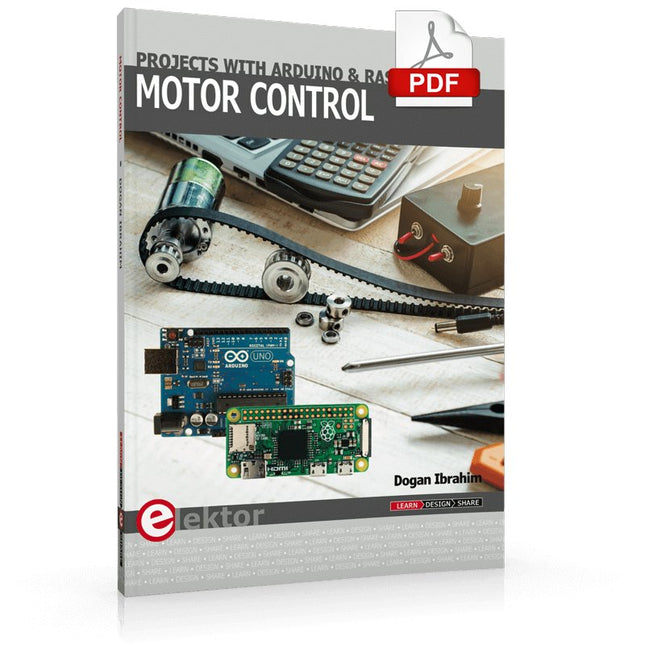
Elektor Digital Motor Control - Projects with Arduino & Raspberry Pi (E-book)
This book is about DC electric motors and their use in Arduino and Raspberry Pi Zero W based projects. The book includes many tested and working projects where each project has the following sub-headings: Title of the project Description of the project Block diagram Circuit diagram Project assembly Complete program listing of the project Full description of the program The projects in the book cover the standard DC motors, stepper motors, servo motors, and mobile robots. The book is aimed at students, hobbyists, and anyone else interested in developing microcontroller based projects using the Arduino Uno or the Raspberry Pi Zero W. One of the nice features of this book is that it gives complete projects for remote control of a mobile robot from a mobile phone, using the Arduino Uno as well as the Raspberry Pi Zero W development boards. These projects are developed using Wi-Fi as well as the Bluetooth connectivity with the mobile phone. Readers should be able to move a robot forward, reverse, turn left, or turn right by sending simple commands from a mobile phone. Full program listings of all the projects as well as the detailed program descriptions are given in the book. Users should be able to use the projects as they are presented, or modify them to suit to their own needs.
€ 29,95
Membres € 23,96
-

JOY-iT JOY-iT MotoPi – Motor Control for Raspberry Pi
Le MotoPi est une carte d'extension permettant de contrôler et d'utiliser jusqu'à 16 servomoteurs 5 V contrôlés par PWM. La carte peut être alimentée en plus par une tension comprise entre 4,8 V et 6 V, ce qui garantit toujours une alimentation parfaite et permet d'alimenter même des projets plus importants. Avec l'alimentation supplémentaire et le convertisseur analogique-numérique intégré, de nouvelles possibilités peuvent être atteintes. Une alimentation supplémentaire par moteur n'est plus nécessaire car toutes les connexions (Tension, Terre, Contrôle) sont directement connectées à la carte. Le contrôle et la programmation peuvent se faire directement, comme d'habitude, sur le Raspberry Pi. Fonctionnalités spéciales 16 canaux, propre générateur d'horloge, Incl. Convertisseur analogique-numérique Entrée 1 Connecteur d'alimentation coaxial 5,5 / 2,1 mm, 5 V / 6 A max Entrée 2 Bornier à vis, 4,8-6 V / 6 A max Compatible avec Framboise Pi A+, B+, 2B, 3B Dimensions 65x56x24mm Etendue de la livraison Tableau, manuel, matériel de fixation
€ 26,95
Membres € 24,26
-

Elektor Digital Hardware Projects for Raspberry Pi (E-book)
The Raspberry Pi is a $35 credit-card sized computer with many applications, such as in desktop computing, audio and video playback, and as a controller in many industrial, commercial and domestic applications. This book is about the Raspberry Pi computer and its use in control applications. The book explains in simple terms, with examples, how to configure the RPi, how to install and use the Linux operating system, how to write programs using the Python programming language and how to develop hardware based projects. The book starts with an introduction to the Raspberry Pi computer and covers the topics of purchasing all the necessary equipment and installing/using the Linux operating system in command mode. Use of the user-friendly graphical desktop operating environment is explained using example applications. The RPi network interface is explained in simple steps and demonstrates how the computer can be accessed remotely from a desktop or a laptop computer. The remaining parts of the book cover the Python programming language, hardware development tools, hardware interface details, and RPi based hardware projects. All the 23 projects given in the book have been tested and are working. The following headings are given for each project: Project title Project description Project block diagram Project circuit diagram Project program description using the Program Description Language (PDL) Complete program listing Description of the program The book is ideal for self-study, and is intended for electronic/electrical engineering students, practising engineers, research students, and hobbyists.
€ 34,95
Membres € 27,96
-

Elektor Digital Using Displays in Raspberry Pi Projects (E-book)
Learn to program displays and GUIs with Python This book is about Raspberry Pi 4 display projects. The book starts by explaining how to install the latest Raspbian operating system on an SD card, and how to configure and use the GPIO ports. The core of the book explains the following topics in simple terms with fully tested and working example projects: Simple LED projects Bar graph LED projects Matrix LED projects Bitmap LED projects LED strips LCDs OLED displays E-paper displays TFT displays 7-inch touch screen GUI Programming with Tkinder One unique feature of this book is that it covers almost all types of display that readers will need to use in their Raspberry Pi based projects. The operation of each project is fully given, including block diagrams, circuit diagrams, and commented full program listings. It is therefore an easy task to convert the given projects to run on other popular platforms, such as Arduino or PIC microcontrollers. Python program listings of all Raspberry Pi projects developed in this book are available for download at Elektor.com. Readers can use these programs in their projects. Alternatively, they can modify the programs to suit their applications.
€ 32,95
Membres € 26,36
-
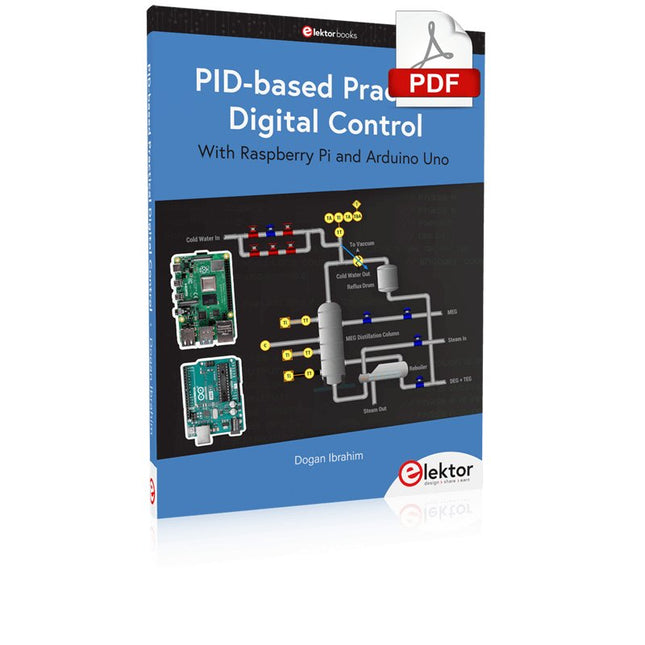
Elektor Digital PID-based Practical Digital Control with Raspberry Pi and Arduino Uno (E-book)
The Arduino Uno is an open-source microcontroller development system encompassing hardware, an Integrated Development Environment (IDE), and a vast number of libraries. It is supported by an enormous community of programmers, electronic engineers, enthusiasts, and academics. The libraries in particular really smooth Arduino programming and reduce programming time. What’s more, the libraries greatly facilitate testing your programs since most come fully tested and working. The Raspberry Pi 4 can be used in many applications such as audio and video media devices. It also works in industrial controllers, robotics, games, and in many domestic and commercial applications. The Raspberry Pi 4 also offers Wi-Fi and Bluetooth capability which makes it great for remote and Internet-based control and monitoring applications. This book is about using both the Raspberry Pi 4 and the Arduino Uno in PID-based automatic control applications. The book starts with basic theory of the control systems and feedback control. Working and tested projects are given for controlling real-life systems using PID controllers. The open-loop step time response, tuning the PID parameters, and the closed-loop time response of the developed systems are discussed together with the block diagrams, circuit diagrams, PID controller algorithms, and the full program listings for both the Raspberry Pi and the Arduino Uno. The projects given in the book aim to teach the theory and applications of PID controllers and can be modified easily as desired for other applications. The projects given for the Raspberry Pi 4 should work with all other models of Raspberry Pi family. The book covers the following topics: Open-loop and closed-loop control systems Analog and digital sensors Transfer functions and continuous-time systems First-order and second-order system time responses Discrete-time digital systems Continuous-time PID controllers Discrete-time PID controllers ON-OFF temperature control with Raspberry Pi and Arduino Uno PID-based temperature control with Raspberry Pi and Arduino Uno PID-based DC motor control with Raspberry Pi and Arduino Uno PID-based water level control with Raspberry Pi and Arduino Uno PID-based LED-LDR brightness control with Raspberry Pi and Arduino Uno
€ 32,95
Membres € 26,36
-

JOY-iT JOY-iT Motorino – Motor Control for Arduino
La carte Motorino est une carte d'extension permettant de contrôler et d'utiliser jusqu'à 16 servomoteurs 5 V contrôlés par PWM. Le générateur d'horloge inclus fournit un signal PWM très précis et un positionnement très précis. La carte dispose de 2 entrées pour une tension de 4,8 V à 6 V qui peuvent être utilisées pour un maximum de 11 A. Avec cette entrée, une alimentation électrique parfaite est toujours garantie et même les projets les plus importants ne posent aucun problème. L'alimentation électrique passe directement par le Motorino, qui fournit une connexion pour la tension, la terre et le contrôle. Le condensateur intégré tamponne la tension, ce qui évite une chute soudaine de tension en cas de charge élevée. Mais il existe également la possibilité de connecter un autre condensateur. Le contrôle et la programmation peuvent être effectués, comme d'habitude, avec l'Arduino. Les manuels et les exemples de code permettent une introduction rapide pour les débutants. Fonctionnalités spéciales 16 canaux, propre générateur d'horloge Entrée 1 Connecteur d'alimentation coaxial 5,5 / 2,1 mm, 4,8-6 V / 5 A max Entrée 2 Bornier à vis, 4,8-6 V / 6 A max Communication 16xPWM Compatible avec Microcontrôleur Arduino Uno, Mega et peut-être plus avec brochage compatible Arduino Dimensions 69x24x56mm Portée Carton, manuel, emballage de vente au détail
€ 26,95
Membres € 24,26
-

Elektor Publishing Control Your Home with Raspberry Pi
Secure, Modular, Open-Source and Self-Sufficient Ever since the Raspberry Pi was introduced, it has been used by enthusiasts to automate their homes. The Raspberry Pi is a powerful computer in a small package, with lots of interfacing options to control various devices. This book shows you how you can automate your home with a Raspberry Pi. You’ll learn how to use various wireless protocols for home automation, such as Bluetooth, 433.92 MHz radio waves, Z-Wave, and Zigbee. Soon you’ll automate your home with Python, Node-RED, and Home Assistant, and you’ll even be able to speak to your home automation system. All this is done securely, with a modular system, completely open-source, without relying on third-party services. You’re in control of your home, and no one else. At the end of this book, you can install and configure your Raspberry Pi as a highly flexible home automation gateway for protocols of your choice, and link various services with MQTT to make it your own system. This DIY (do it yourself) approach is a bit more laborious than just installing an off-the-shelf home automation system, but in the process, you can learn a lot, and in the end, you know exactly what’s running your house and how to tweak it. This is why you were interested in the Raspberry Pi in the first place, right? Turn your Raspberry Pi into a reliable gateway for various home automation protocols. Make your home automation setup reproducible with Docker Compose. Secure all your network communication with TLS. Create a video surveillance system for your home. Automate your home with Python, Node-RED, Home Assistant and AppDaemon. Securely access your home automation dashboard from remote locations. Use fully offline voice commands in your own language. Downloads Errata on GitHub
€ 44,95
Membres € 40,46
-

Elektor Publishing PLC Programming with the Raspberry Pi and the OpenPLC Project
ModbusRTU and ModbusTCP examples with the Arduino Uno and ESP8266 Introduction to PLC programming with OpenPLC, the first fully open source Programmable Logic Controller on the Raspberry Pi, and Modbus examples with Arduino Uno and ESP8266 PLC programming is very common in industry and home automation. This book describes how the Raspberry Pi 4 can be used as a Programmable Logic Controller. Before taking you into the programming, the author starts with the software installation on the Raspberry Pi and the PLC editor on the PC, followed by a description of the hardware. You'll then find interesting examples in the different programming languages complying with the IEC 61131-3 standard. This manual also explains in detail how to use the PLC editor and how to load and execute the programs on the Raspberry Pi. All IEC languages are explained with examples, starting with LD (Ladder Diagram) over ST (Structured Control Language) to SFC (Special Function Chart). All examples can be downloaded from the author's website. Networking gets thorough attention too. The Arduino Uno and the ESP8266 are programmed as ModbusRTU or ModbusTCP modules to get access to external peripherals, reading sensors and switching electrical loads. I/O circuits complying with the 24 V industry standard may also be of interest for the reader. The book ends with an overview of commands for ST and LD. After reading the book, the reader will be able to create his own controllers with the Raspberry Pi.
€ 39,95
Membres € 35,96
-

Elektor Publishing Régulation PID par la pratique avec Raspberry Pi et Arduino Uno
Arduino Uno est une plaque de développement de microcontrôleur, avec superposition de code source (matériel, EDI et bibliothèques). Arduino est l'une des plus grandes communautés de programmeurs, d'ingénieurs et d'électroniciens, de passionnés et d'étudiants universitaires. Merci pour vos bibliothèques, le programme devient adapté à votre jeune enfant et la rapidité. Les bibliothèques entièrement testées et fonctionnelles facilitent le test des programmes. Le Raspberry Pi 4, une version récente du système nano-ordonné, est utilisé pour les appareils multimédias, ainsi que pour les applications industrielles, robotiques, domestiques et commerciales. Grâce à la connectivité Wi-Fi et Bluetooth, votre Raspberry Pi 4 est parfait pour la commande et la surveillance à distance via Internet. Ce livre avec une œuvre de Raspberry Pi 4 et de l'Arduino Uno dans des applications de régulation avec l'algorithme PID. Après avoir examiné la théorie des systèmes de régulation et des systèmes intégrés, l'évaluation des fonctions du projet et les tests de pilotage des systèmes de régulation PID en temps réel. Le timing et la structure des paramètres PID et le timing et la structure des systèmes détaillés et détaillés (schémas fonctionnels, schémas de circuits, algorithmes de régulation PID, liste complète des cartes). Ces projets s'appuient constamment sur la théorie et les applications des régulateurs PID. C'est un simple modificateur pour d'autres applications. Les projets pour le Raspberry Pi 4 sont adaptables selon les différents modèles de la famille Raspberry Pi. Le livre couvre les sujets suivants : Systèmes de régulation et systèmes ouverts et fermés Capteurs analogiques et numériques Fonctions de transfert et de système en continu Enregistrements temporels des systèmes du 1er et du 2ème ordre Systèmes discrets (nombres) Les régulateurs PID sont des systèmes à température continue Numéros PID des régulateurs Régulation de température selon Raspberry Pi et Arduino Uno Régulation de température PID à l'aide de Raspberry Pi et Arduino Uno Pilotage continu de moteurs utilisant Raspberry Pi et Arduino Uno Régulation PID pour surveiller le niveau du Raspberry Pi et de l'Arduino Uno Régulation PID pour piloter une LED avec Raspberry Pi et Arduino Uno
€ 39,95
Membres € 35,96
-
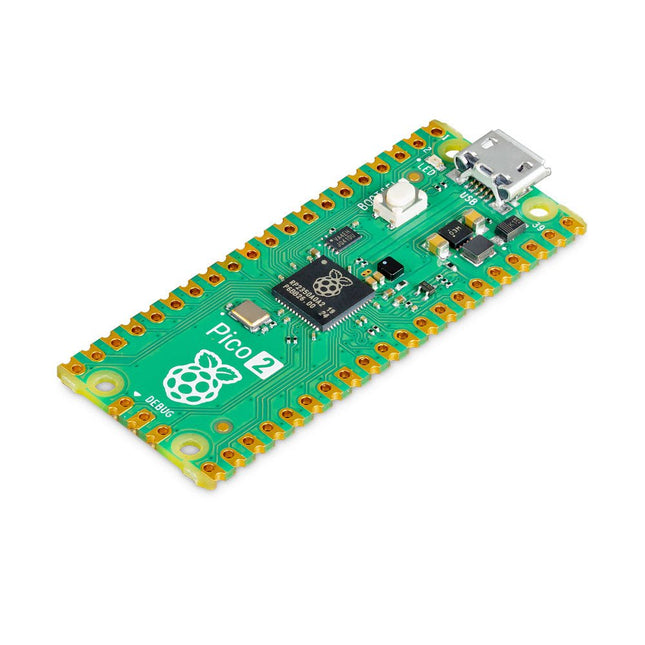
Raspberry Pi Foundation Raspberry Pi Pico 2
Le Raspberry Pi Pico 2 est une nouvelle carte microcontrôleur de la Raspberry Pi Foundation, basée sur le RP2350. Il présente une vitesse d'horloge de cœur plus élevée, le double de la SRAM sur puce, le double de la mémoire flash intégrée, des cœurs Arm plus puissants, des cœurs RISC-V en option, de nouvelles fonctionnalités de sécurité et des capacités d'interface améliorées. Le Raspberry Pi Pico 2 offre une amélioration significative des performances et des fonctionnalités tout en conservant la compatibilité matérielle et logicielle avec les membres précédents de la série Raspberry Pi Pico. Le RP2350 fournit une architecture de sécurité complète construite autour d'Arm TrustZone pour Cortex-M. Il intègre un démarrage signé, 8 Ko d'OTP antifusible pour le stockage des clés, une accélération SHA-256, un TRNG matériel et des détecteurs de problèmes rapides. La capacité unique à double cœur et à double architecture du RP2350 permet aux utilisateurs de choisir entre une paire de cœurs Arm Cortex-M33 standard et une paire de cœurs Hazard3 RISC-V à matériel ouvert. Programmable en C/C++ et Python, et pris en charge par une documentation détaillée, le Raspberry Pi Pico 2 est la carte microcontrôleur idéale pour les passionnés et les développeurs professionnels. Spécifications Processeur Processeurs Dual Arm Cortex-M33 ou double RISC-V Hazard3 à 150 MHz Mémoire 520 Ko de SRAM sur puce ; Flash QSPI intégré de 4 Mo Interfaces 26 broches GPIO polyvalentes, dont 4 pouvant être utilisées pour AD Périphériques 2x UART 2x Contrôleurs SPI 2x Contrôleurs I²C 24x Canaux PWM 1x Contrôleur USB 1.1 et PHY, avec prise en charge des hôtes et des périphériques 12x Machines à états PIO Puissance d'entrée 1,8-5,5 V CC Dimensions 21 x 51 mm Téléchargements Datasheet (Pico 2) Datasheet (RP2350)
€ 5,95
Membres identique
-
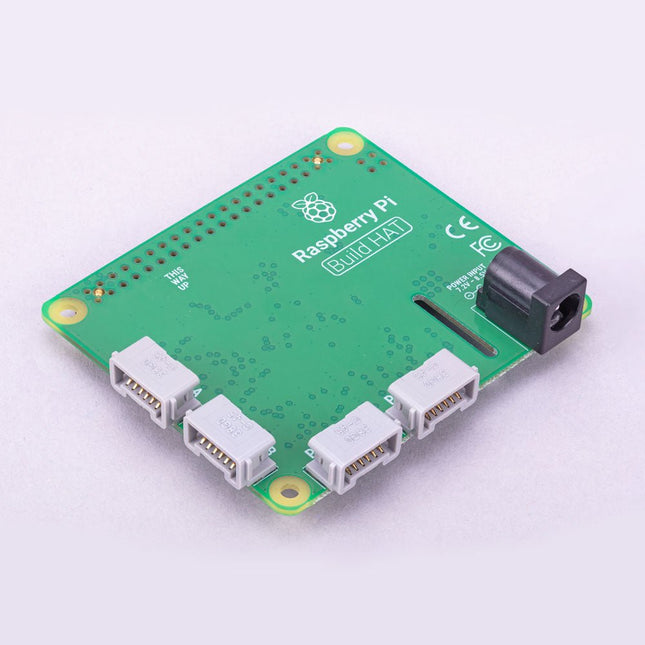
Raspberry Pi Foundation Raspberry Pi Build HAT
Construisez des machines robustes et intelligentes qui combinent la puissance de calcul du Raspberry Pi avec des composants LEGO. Le Raspberry Pi Build HAT fournit quatre connecteurs pour les moteurs et capteurs LEGO Technic du portefeuille SPIKE. Les capteurs disponibles comprennent un capteur de distance, un capteur de couleur et un capteur de force polyvalent. Les moteurs angulaires sont disponibles dans une gamme de tailles et comprennent des encodeurs intégrés qui peuvent être interrogés pour trouver leur position. Le Build HAT s'adapte à tous les ordinateurs Raspberry Pi dotés d'un connecteur GPIO à 40 broches, y compris – avec l'ajout d'un câble ruban ou d'un autre périphérique d'extension – le Raspberry Pi 400. Les appareils LEGO Technic connectés peuvent facilement être contrôlés en Python, aux côtés des accessoires Raspberry Pi standard. tel qu'un module de caméra. Caractéristiques Contrôle jusqu'à 4 moteurs et capteurs Alimente le Raspberry Pi (lorsqu'il est utilisé avec un bloc d'alimentation externe approprié) Facile à utiliser depuis Python sur le Raspberry Pi
€ 29,95€ 14,95
Membres identique
-
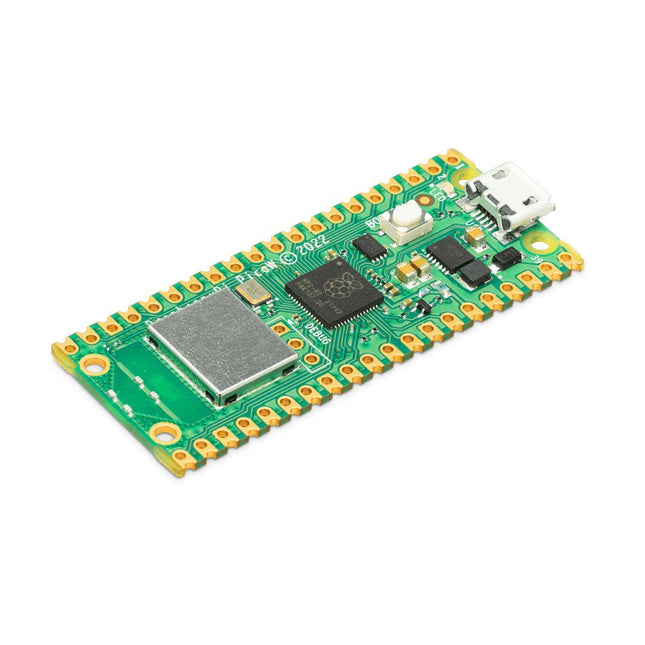
Raspberry Pi Foundation Raspberry Pi Pico W
Raspberry Pi Pico W est une carte microcontrôleur basée sur la puce microcontrôleur Raspberry Pi RP2040. La puce microcontrôleur RP2040 (Raspberry Silicon) offre un processeur ARM Cortex-M0+ à double cœur (133 MHz), 256 Ko de RAM, 30 broches GPIO et de nombreuses autres options d'interface. En outre, il y a 2 Mo de mémoire flash QSPI embarquée pour le stockage du code et des données. Raspberry Pi Pico W a été conçu pour être une plateforme de développement flexible et peu coûteuse pour RP2040 avec une interface sans fil de 2,4 GHz utilisant un Infineon CYW43439. L'interface sans fil est connectée via SPI au RP2040. Caractéristiques du Pico W Microcontrôleur RP2040 avec 2 Mo de mémoire flash Interfaces sans fil monobande 2,4 GHz intégrées (802.11n) Port Micro USB-B pour l'alimentation et les données (et pour la reprogrammation de la flash) Carte DIP à 40 contacts de 21 x 51 mm, d'une épaisseur de 1 mm, avec broches espacées de 0,1' et avec bords canelés. Expose 26 E/S multifonctions 3,3 V à usage général (GPIO) 23 GPIO sont uniquement numériques, trois entrées analogiques. Peut être monté en surface comme un module Port de débogage série (SWD) ARM à 3 connecteurs Architecture d'alimentation simple mais très flexible Diverses options permettant d'alimenter facilement l'unité à partir d'un micro USB, d'une alimentation externe ou d'une batterie. Haute qualité, faible coût, haute disponibilité SDK complet, exemples de logiciels et documentation Caractéristiques du microcontrôleur RP2040 Cortex-M0+ à double cœur jusqu'à 133 MHz La PLL intégrée permet de faire varier la fréquence du cœur SRAM haute performance multi-bancs de 264 Ko Flash Quad-SPI externe avec eXecute In Place (XIP) et cache sur puce de 16 Ko Bus multiplexeur haute performance USB1.1 intégré (périphérique ou hôte) 30 E/S multifonctions à usage général (quatre peuvent être utilisées pour le CAN) Tension d'E/S de 1,8-3,3 V Convertisseur analogique-numérique (CAN) 12 bits 500 ksps Divers périphériques numériques 2x UART, 2x I²C, 2x SPI, 16x canaux PWM 1x minuterie avec 4 alarmes, 1x horloge en temps réel 2x blocs d'E/S programmables (PIO), 8 machines d'état au total E/S haute vitesse flexibles et programmables par l'utilisateur Peut émuler des interfaces telles que la carte SD et VGA Note : la tension des E/S du Raspberry Pi Pico W est fixée à 3,3 V. Téléchargements Fiche technique Spécifications du connecteur de débogage à 3 contacts
€ 7,95
Membres identique











